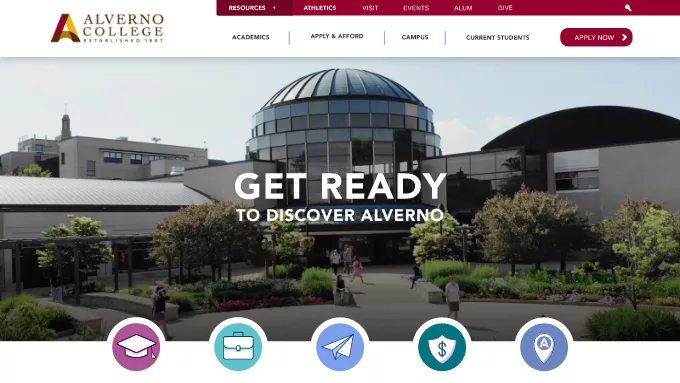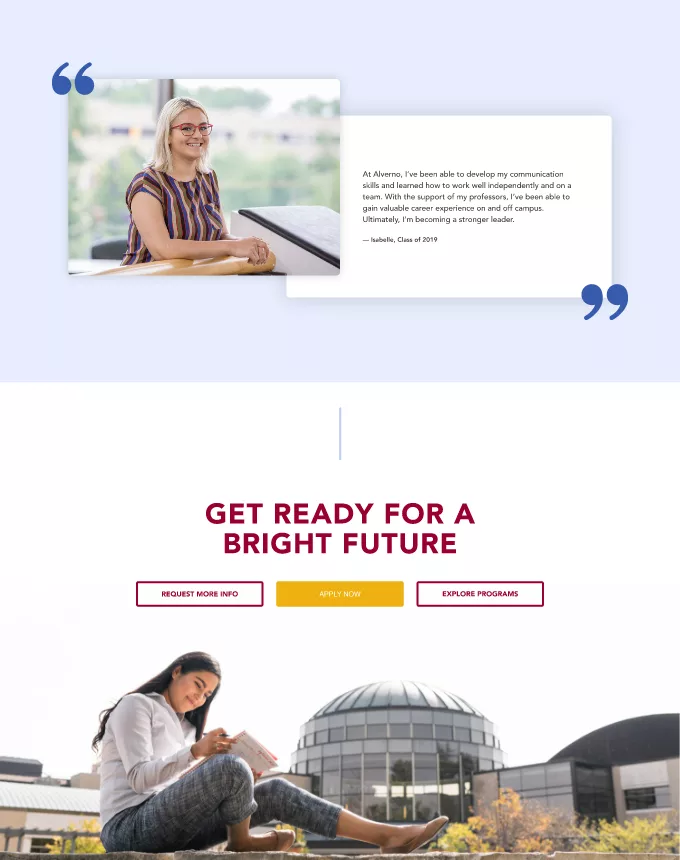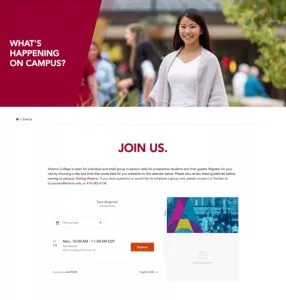
Your major donors provide your university with invaluable support, enabling you to enhance your academics and improve your campus all around. To create highly effective major donation appeals, relationships with your major donors must be slowly built over time through a series of one-on-one interactions. Outside of these conversations, your major donors undoubtedly research your university on their own, and one of the first places they’ll look to learn more is your website.
University websites reflect the mission of the organization behind them. This means your donors, both big and small, will use your website to determine if your university’s values align with theirs and is worth donating to. Additionally, your website’s presentation and overall design will also communicate your university’s professionalism and style, which can also impact your donors’ impression of your organization.
This means you need to ensure the image you present on your website mirrors the impression you are leaving in your individual conversations with major donors.
To align your website with your major donors’ expectations about your organization, this guide will present four ways to ensure your university’s website fully conveys your school’s values and academic offerings, including:
- Display your brand identity.
- Build a personal connection.
- Describe how donations will be used.
- Explain how to get involved.
Today, most donors expect all universities, big and small, to have professionally designed websites. Fortunately, you don’t need to be an expert in web design to create a modern, dynamic website that enhances donor relationships. With powerful and easy-to-use web design tools, you’ll be able to offer the right content in a creative layout, empowering your organization to get your message across to everyone who visits your site.
Display your brand identity.
Many of your external marketing materials such as emails and social media posts will limit how your university can show off your brand. By contrast, your website allows your university to display your brand however you want.
Your major donors have likely interacted with many of your marketing materials and are familiar with the basic elements of your brand. When they visit your website, everything they’ve learned about your university’s values and identity should come together in one cohesive design.
Keep in mind that your brand is more than just your logos and a few colors. While your website should unquestionably display those elements, you can also strengthen your website’s ability to communicate your brand by:
- Being consistent across all web pages. Core visual brand elements like your logo and official colors create a consistent experience for your website’s visitors. Along with boosting your website’s professionalism, uniformly displaying your logo, colors, and other branded elements on all of your website’s pages helps reassure visitors that they are still on your website whenever they click a link.
- Displaying a clear mission statement. Your mission statement should encapsulate your university’s core values, and every aspect of your website should align itself with this statement about what your university stands for. Make sure your mission statement is easy for visitors to find and encompasses the main values you want to communicate to major donors.
- Conveying your brand values in all content. Whether your website features videos, images, or primarily text, all of your content should support your brand. For example, you might display a variety of photos in an image carousel on one of your pages. For some universities, their brand identities might align with colorful displays with several photos, while others would be better suited adding a filter with one of their brand colors over the images.

As Morweb’s guide to school website builders emphasizes, your website’s platform will shape how you’re able to communicate your brand. When you research website builders, keep an eye out for ones that focus on their customizability and branding options. Many website builders come with pre-made templates, which can help guide your website creation process. Just be sure that the templates are customizable to ensure you can convey core elements of your brand identity.
Build a personal connection.
To build relationships with your major donors, you’ll first need to know who they are before you can develop content that appeals to them, and part of that is determining who qualifies as a major donor. Whether or not a donation qualifies as a major gift depends on your university’s usual donation size.
Nonprofit.Courses’ major gifts guide offers several strategies for determining who counts as a major donor, including more straightforward metrics such as dollar amounts and percent of your total donations. However, they also advise keeping in mind how certain gifts can be transformative or emotionally impactful.
For example, gifts donated to your university at a key moment to help complete a project may be smaller than what would technically qualify as a major gift but still be cause for celebration. No matter how rigidly you choose to define your major donors, it is still in your university’s best interest to cultivate positive relationships with everyone who makes a meaningful contribution to your organization.
The question, then, is how can you begin this relationship? One-on-one conversations with your major gifts team can help you cultivate personal connections with your donors, but your website can determine whether your major donors form an emotional connection to your university in the first place.
The right website design can encourage donors to become invested in your university. A few website elements that can help accomplish this are:
- Photos of your staff and students. It’s commonly stated that a picture is worth a thousand words, and oftentimes, a well-chosen photo can help instill a personal bond much faster than a block of text. Photos of your staff and students learning in the classroom, football players at a big rivalry game, cheerleaders participating in a fundraising event, or faculty and staff serving their community can help donors better visualize who and what their gifts will support.
- Testimonials from former students. While facts and statistics may help some donors determine which universities their donations will most benefit, anecdotes can go a long way toward helping donors envision what your university means for the individuals living and learning there. Collect testimonials that explain how your university can impact individual lives for the better from alumni, staff, and researchers to share on your website.
- Major donor appreciation pages. The most straightforward way to bond with your major donors is to say thank you. While some donors may prefer private messages of appreciation, others enjoy the public acknowledgment that a thank-you page on your website provides. For example, you might create a virtual “donor wall” thanking donors who gave in a recent online fundraiser Spotlighting your major donors may also help persuade major donor prospects to consider joining those already showcased on your website.

When sharing personal and emotional stories and photos, some universities tend to exaggerate their impact or needlessly dramatize the stories they collect. While you can adjust the exact wording of the stories you gather to increase comprehension, make sure that you stick to the truth and build your personal connections with major donors on a foundation of honesty.
Describe how donations will be used.
Few donors, especially major donors, will blindly donate to organizations without knowing where their money is going. Your major donors are making a big investment in your university, so make sure your website is transparent about which programs and initiatives donations will fund.
Be conscious of where and how you describe the way you intend to use your donations. A comprehensive, downloadable donation impact report can help convey the numbers to supporters willing to take the time to research your organization. You could also offer a livestream event where you answer questions and clearly articulate your university’s needs and how donations will help. However, some major donors may prefer a quicker, to-the-point explanation, so make sure multiple options are available on your website.
Some fundraisers, like Giving Tuesday campaigns and other giving day fundraisers, encourage donors, including your major donors, to give within a short timeframe. These fundraisers benefit from keeping all of your core information in one, centralized place, so donors can quickly and easily understand what their donations will support from just your donation page.
Explain how to get involved.
Remember that your major donors aren’t just ATMs for your university. While some may be content to keep their involvement to an annual donation, others will want to further their investment and participation in your university by getting involved in other areas of the school.
Make sure your major donors can find information about how to get involved from more channels than just one-on-one conversations with your major gift officers. Here are just a few ways your major donors can get involved and how your website can help promote these approaches:
- Some major donors like to get personally involved with the organizations they support, and that includes your university. Make sure your university has a “Get Involved” page that offers a range of volunteer opportunities, so your major donors can find a way to help out that fits their skills and interests.
- Your major donor outreach team should extend personal event invitations to your major donors, but you should still be sure to make your event information easy to find on your website. Displaying a full calendar of events for both major donors and your university’s population at large will also help present your university as active and engaging.
- Non-monetary contributions. Your university’s wealth prospecting may reveal that some of your major donors have additional resources they can give outside of monetary donations. For example, some may have business connections and can help your university network with potential sponsors, while others might have nearby property and can provide additional event space at a reduced cost. On your website, make sure your donation page has a contact form or way that major donors can provide additional information about how they want to contribute.

Providing many opportunities for your websites’ visitors to get involved can signal to donors that your university is open to help and ready to listen to what their donors have to say. Not to mention, making sure your volunteer, event, and donation forms are easy to find helps increase your website’s usability for all visitors, including your major donors.
The Gist
Your major donors power your university, providing the funding to help your students learn and your researchers make new discoveries. Make sure your nonprofit is making the best impression possible online by creating a website that proudly displays your brand identity and guides major donors through the giving process in between conversations with your team.

Guest Author – Murad Bushnaq is the Founder and CEO of Morweb. Since its inception in 2014, Murad has acted as Creative Director and Chief Technologist to help nonprofits spread their vision online through engaging design, intuitive software and strategic communication.



